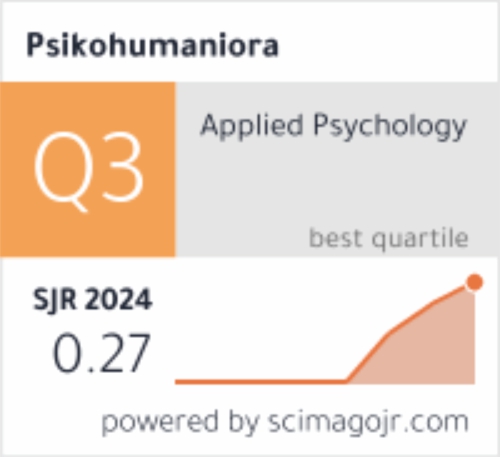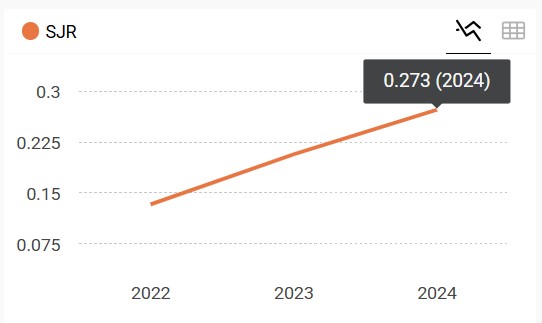The role of classroom management and mastery goal orientation towards student’s self-regulation in learning Mathematics
DOI:
https://doi.org/10.21580/pjpp.v4i2.3576Keywords:
mastery goal orientation, classroom management, self-regulation, learning MathematicsAbstract
Mathematics until today is still considered a difficult subject so that it needs to think about appropriate strategies to encourage students to be able to regulate themselves in learning this subject. This study aimed to test empirically the role of classroom management and mastery goal orientation towards self-regulated learning. The participants of the study were 177 students of state high schools in Sleman, who were selected using a purposive sampling technique. The scales used were self-regulation of mathematics learning scale, classroom management scale, and mastery goal orientation scale. The data analysis using two-predictor regression analysis showed that classroom management and mastery goal simultaneously played a significant role by 68.7% (R2=0.687, F (2.177) =191.243, p<0.01). Classroom management predicted self-regulation (β= -0.130, p < 0.01), and so did mastery goal (β= 0.878, p < 0.01). Based on the results of this study, it could be concluded that self-regulation in learning Mathematics can be determined through classroom management and mastery goals concurrently.Downloads
References
Bandura, A. (1986). Social foundations of thought and action: A social cognitive theory. In Social foundations of thought and action: A social cognitive theory. New Jersey: Prentice Hall, Inc., Englewood Cliffs.
Banich, M. T., & Compton, R. J. (2011). Cognitive neuroscience (3rd ed.). Belmont: Wadsworth, Cengage Learning.
Barenberg, J., Berse, T., & Dutke, S. (2011). Executive functions in learning processes: Do they benefit from physical activity? Educational Research Review, 6(3), 208–222. https://doi.org/10.1016/j.edurev.2011.04.002
Belenky, D. M., & Nokes-Malach, T. J. (2012). Motivation and transfer: The role of mastery-approach goals in preparation for future learning. Journal of the Learning Sciences, 21(3), 399–432. https://doi.org/10.1080/10508406.2011.651232
Bell, C. V., & Pape, S. J. (2014). Scaffolding the development of self-regulated learning in Mathematics classrooms. Middle School Journal, 45(4), 23–32. https://doi.org/10.1080/00940771.2014.11461893
Boekaerts, M., & Cascallar, E. (2006). How far have we moved toward the integration of theory and practice in self-regulation? Educational Psychology Review, 18(3), 199–210. https://doi.org/10.1007/s10648-006-9013-4
Booker, K. C., & Lim, J. H. (2018). Belongingness and pedagogy: Engaging African American girls in middle school Mathematics. Youth and Society, 50(8), 1037–1055. https://doi.org/10.1177/0044118X16652757
Bostwick, K. C. P., Martin, A. J., Collie, R. J., & Durksen, T. L. (2019). Growth orientation predicts gains in middle and high school students’ Mathematics outcomes over time. Contemporary Educational Psychology, 58, 213–227. https://doi.org/10.1016/j.cedpsych.2019.03.010
Boyd, P., & Ash, A. (2018). Mastery Mathematics: Changing teacher beliefs around in-class grouping and mindset. Teaching and Teacher Education, 75, 214–223. https://doi.org/10.1016/j.tate.2018.06.016
Cahyani, B. H. (2010). Pelatihan regulasi metakognisi untuk meningkatkan kebiasaan belajar. Yogyakarta: Universitas Sarjanawiyata Tamansiswa.
Cahyani, B. H., & Alsa, A. (2008). Efektivitas pelatihan regulasi metakognisi untuk meningkatkan kemampuan memecahkan problem Matematika. (Unpublished thesis). Universitas Gadjah Mada.
Carneiro, R., Lefrere, P., Steffens, K., & Underwood, J. (2011). Self-regulated learning in technology-enhanced learning environments a European perspective (5th ed.). Rotterdam: Sense Publisher.
Chatzisarantis, N. L. D., Nilay Ada, E., Bing, Q., Papaioannou, A., Prpa, N., & Hagger, M. S. (2016). Clarifying the link between mastery goals and social comparisons in classroom settings. Contemporary Educational Psychology, 46, 61–72. https://doi.org/10.1016/j.cedpsych.2016.04.009
Cheung, C., Cheung, H. Y., & Hue, M. (2017). Educational contributions to students’ belongingness to the society, neighbourhood, school and family. International Journal of Adolescence and Youth, 22(2), 226–237. https://doi.org/10.1080/02673843.2016.1157827
Chung, M.-K. (2000). The development of self-regulated learning. Asia Pacific Education Review, 1(1), 55–66. https://doi.org/10.1007/bf03026146
Djigic, G., & Stojiljkovic, S. (2011). Classroom management styles, classroom climate and school achievement. Procedia - Social and Behavioral Sciences, 29, 819–828. https://doi.org/10.1016/j.sbspro.2011.11.310
Endedijk, M. D., Brekelmans, M., Verloop, N., Sleegers, P. J. C., & Vermunt, J. D. (2014). Individual differences in student teachers’ self-regulated learning: An examination of regulation configurations in relation to conceptions of learning to teach. Learning and Individual Differences, 30, 155–162. https://doi.org/10.1016/j.lindif.2013.12.005
Erawati, M. (2016). Pembentukan rapport di kelas: Analisis psikologi. Psikohumaniora: Jurnal Penelitian Psikologi, 1(1), 75. https://doi.org/10.21580/pjpp.v1i1.1001
Fadlelmula, F. K. (2010). Educational motivation and students’ achievement goal orientations. Procedia - Social and Behavioral Sciences, 2(2), 859–863. https://doi.org/10.1016/j.sbspro.2010.03.116
Gonida, E. N., Karabenick, S. A., Makara, K. A., & Hatzikyriakou, G. A. (2014). Perceived parent goals and student goal orientations as predictors of seeking or not seeking help: Does age matter? Learning and Instruction, 33, 120–130. https://doi.org/10.1016/j.learninstruc.2014.04.007
Grau, V., Lorca, A., Araya, C., Urrutia, S., Ríos, D., Montagna, P., & Ibaceta, M. (2018). Socially shared regulation of learning and quality of talk: Age differences in collaborative group work in classroom contexts. New Directions for Child and Adolescent Development, 2018(162), 11–39. https://doi.org/10.1002/cad.20261
Haan, de M. (2014). Attention and executive control. In Educational neuroscience (1st ed., p. 326). West Sussex: Willey Blackwel.
Hafen, C. A., & Ruzek, E. A. (2015). Classroom Level in Educational Effectiveness Research. In International Encyclopedia of the Social & Behavioral Sciences (pp. 833–838). Elsevier. https://doi.org/10.1016/B978-0-08-097086-8.92127-5
Hejazi, E., Naghsh, Z., Sangari, A. A., & Tarkhan, R. A. (2011). Prediction of academic performance: The role of perception of the class structure, motivation and cognitive variables. Procedia - Social and Behavioral Sciences, 15, 2063–2067. https://doi.org/10.1016/j.sbspro.2011.04.054
Jones, V., & Jones, L. (2012). Manajemen kelas komprehensif. (I. Irawati, Trans.) (9th ed.). Jakarta: Kencana Prenada Media Group.
Kareshki, H. (2011). Relations among perceptions of classroom activities and self-regulating learning. Procedia - Social and Behavioral Sciences, 12, 409–413. https://doi.org/10.1016/j.sbspro.2011.02.050
Keachies, M. (2014). Teaching tips strategies, research and Theory for College and University Teachers (14th ed.). Boston: Wadsworth Cengage Learning.
Kolkman, M. E., Hoijtink, H. J. A., Kroesbergen, E. H., & Leseman, P. P. M. (2013). The role of executive functions in numerical magnitude skills. Learning and Individual Differences, 24, 145–151. https://doi.org/10.1016/j.lindif.2013.01.004
Kumalasari, A., Oktora, R., & Putri, P. E. (2013). Kesulitan belajar Matematika siswa ditinjau dari segi kemampuan koneksi Matematika. In Prosiding Seminar Nasional Matematika dan Pendidikan Matematika (pp. 978–979). Yogyakarta: Jurusan Pendidikan Matematika FMIPA UNY.
Macklem, G. L. (2015). Boredom in the classroom addressing student motivation, self-regulation, and engagement in learning. New York: Springer.
Michou, A., Mouratidis, A., Lens, W., & Vansteenkiste, M. (2013). Personal and contextual antecedents of achievement goals: Their direct and indirect relations to students’ learning strategies. Learning and Individual Differences, 23, 187–194. https://doi.org/10.1016/j.lindif.2012.09.005
Mouratidis, A., Michou, A., Demircioğlu, A. N., & Sayil, M. (2018). Different goals, different pathways to success: Performance-approach goals as direct and mastery-approach goals as indirect predictors of grades in Mathematics. Learning and Individual Differences, 61, 127–135. https://doi.org/10.1016/j.lindif.2017.11.017
Nie, Y., & Lau, S. (2009). Complementary roles of care and behavioral control in classroom management: The self-determination theory perspective. Contemporary Educational Psychology, 34(3), 185–194. https://doi.org/10.1016/j.cedpsych.2009.03.001
Nurhayati, R., & Retnowati, E. (2018). An Analysis of Errors in Solving Limits of Algebraic Function. In Journal of Physics: Conference Series (Vol. 1320, p. 12034). {IOP} Publishing. https://doi.org/10.1088/1742-6596/1320/1/012034
Ormrod, J. E. (2009). Psikologi pendidikan: Membantu siswa tumbuh dan berkembang. (A. Kumara, Trans.) (6th ed.). Jakarta: Erlangga.
Ozkal, N. (2013). The relationship between achievement goal orientations and self regulated learning strategies of secondary school students in social studies courses. International Journal of Academic Research, 5(3), 389–396. https://doi.org/10.7813/2075-4124.2013/5-3/B.59
Özyildirim, F., Alkas, C., & Ozdemir, E. Y. (2011). The factors that affect the preservice Mathematics teachers ’ self regulation strategies. Procedia - Social and Behavioral Sciences, 15, 3543–3549. https://doi.org/10.1016/j.sbspro.2011.04.332
Pamuk, S. (2014). Multilevel analysis of students science achievement in relation to constructivist learning environment perceptions, epistemological beliefs, self-regulation and science teachers characteristics. Middle East Technical University, Ankara, Turkey.
Peeters, J., De Backer, F., Kindekens, A., Triquet, K., & Lombaerts, K. (2016). Teacher differences in promoting students’ self-regulated learning: Exploring the role of student characteristics. Learning and Individual Differences, 52, 88–96. https://doi.org/10.1016/j.lindif.2016.10.014
Pintrich, P. R. (2004). A conceptual framework for assessing motivation and self-regulated learning in college students. Educational Psychology Review, 16(4), 385–407. https://doi.org/10.1007/s10648-004-0006-x
Pintrich, P. R., Smith, D. A. F., Garcia, T., & McKeachie, W. J. (1991). A manual for the use of the Motivated Strategies for Learning Questionnaire (MSLQ. Washington, DC.
Puspitasari, A., Purwanto, E., & Noviyani, D. I. (2013). Self-regulated learning viewed from the goal orientation. Educational Psychology Journal, 2(1), 1–6.
Ramdhani, N. (2012). Menjadi guru inspiratif. Jakarta: Titian Foundation.
Ramos, R. C., & Anonuevo, M. J. T. (2011). Engagement-promoting aspects of teacher’s instructional style and academic self-regulated learning. The International Journal of Research and Review, 7(2), 51–62.
Rashid, K., Abbass, A., Hussain, A., Khalid, N., & Salfi, N. A. (2014). Perceptions of students about classroom management as a contributing factor towards learning at secondary school. Journal of Education and Human Development, 3(2), 713–728.
Rianatha, L., & Sawitri, D. R. (2015). Hubungan antara komunikasi interpersonal guru-siswa dengan self-regulated learning pada siswa SMAN 9 Semarang. Jurnal Empati, 4(2), 209–213.
Sadi, O., & Uyar, M. (2013). The relationship between self-efficacy, self-regulated learning strategies and achievement: A path model. Journal of Baltic Science Education, 12(1), 21–33.
Sakiz, G., Pape, S. J., & Hoy, A. W. (2012). Does perceived teacher affective support matter for middle school students in Mathematics classrooms? Journal of School Psychology, 50(2), 235–255. https://doi.org/10.1016/j.jsp.2011.10.005
Samuelsson, J. (2008). The impact of different teaching methods on students’ arithmetic and self‐regulated learning skills. Educational Psychology in Practice, 24(3), 237–250. https://doi.org/10.1080/02667360802256790
Santrock, J. W. (2009). Psikologi pendidikan, buku 1. (D. Angelica, Trans.) (2nd ed.). Jakarta: Salemba Humanika.
Santrock, J. W. (2011). Perkembangan masa hidup. (B. Widyasinta, Trans.) (13th ed.). Jakarta: Erlangga.
Schunk, D. H., Pintrich, P. R., & Meece, J. L. (2012). Motivasi dalam pendidikan: Teori, penelitian dan aplikasi. (E. Tjo, Trans.) (3rd ed.). Jakarta: Indeks.
Shahmohammadi, N. (2014). Review on the impact of teachers ’ behaviour on students ’ self- regulation. Procedia - Social and Behavioral Sciences, 114, 130–135. https://doi.org/10.1016/j.sbspro.2013.12.672
Skiba, R., Ormiston, H., Martinez, S., & Cummings, J. (2016). Teaching the social curriculum: Classroom management as behavioral instruction. Theory Into Practice, 55(2), 120–128. https://doi.org/10.1080/00405841.2016.1148990
Slavin, R. E. (2011). Psikologi pendidikan. (M. Samosir, Trans.) (2nd ed.). Jakarta: Indeks.
Susetyo, Y. ., & Kumara, A. (2012). Orientasi tujuan, atribusi penyebab, dan belajar berdasar regulasi diri. Jurnal Psikologi, 39(1), 95–111. https://doi.org/10.22146/JPSI.6969
Tanjungsari, R. D., Soedjoko, E., & Mashuri. (2012). Diagnosis kesulitan belajar Matematika SMP pada materi persamaan garis lurus. Unnes Journal of Mathematics Education., 1(1), 53–57. https://doi.org/10.15294/ujme.v1i1.261
Tias, A. A. W., & Wutsqa, D. U. (2015). Analisis kesulitan siswa sma dalam pemecahan masalah Matematika kelas XII IPA di Kota Yogyakarta. Jurnal Riset Pendidikan Matematika, 2(1), 28. https://doi.org/10.21831/jrpm.v2i1.7148
Verdine, B. N., Irwin, C. M., Golinkoff, R. M., & Hirsh-Pasek, K. (2014). Contributions of executive function and spatial skills to preschool Mathematics achievement. Journal of Experimental Child Psychology, 126, 37–51. https://doi.org/10.1016/j.jecp.2014.02.012
Yaghoubi, A. (2013). Critical thinking and goal orientation among English language students. Procedia - Social and Behavioral Sciences, 93, 77–82. https://doi.org/10.1016/j.sbspro.2013.09.155
Yailagh, M. S., Birgani, S. A., Boostani, F., & Hajiyakhchali, A. (2013). The relationship of self-efficacy and achievement goals with metacognition in female high school students in Iran. Procedia - Social and Behavioral Sciences, 84, 117–119. https://doi.org/10.1016/j.sbspro.2013.06.520
Downloads
Published
How to Cite
Issue
Section
License
The copyright of the accepted article shall be assigned to the publisher of the journal. The intended copyright includes the right to publish the article in various forms (including reprints). The journal maintains the publishing rights to published articles.
In line with the license, authors and any users (readers and other researchers) are allowed to share and adapt the material only for non-commercial purposes. In addition, the material must be given appropriate credit, provided with a link to the license, and indicated if changes were made. If authors remix, transform, or build upon the material, authors must distribute their contributions under the same license as the original.



